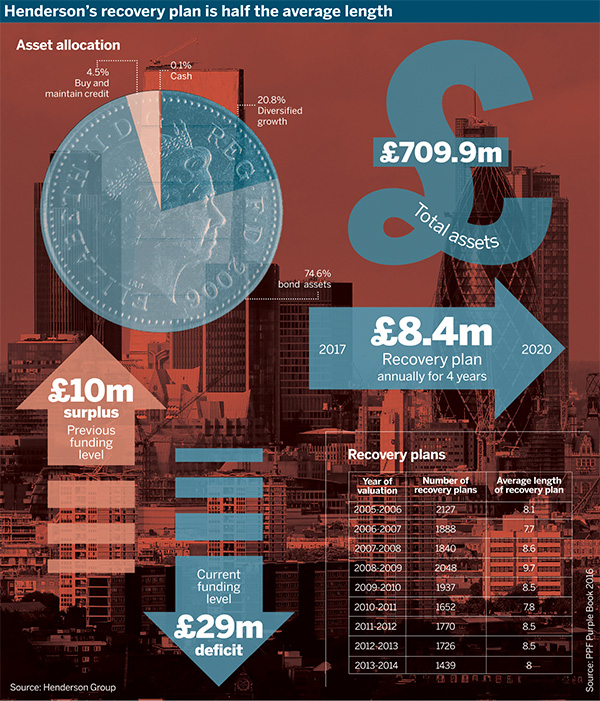Investment manager Henderson Group has agreed a recovery plan with its trustees after its defined benefit scheme fell out of surplus at the latest triennial valuation.
The scheme’s 2014 valuation found the scheme had reached a deficit of £29m on a technical provisions basis, down from a surplus of £10m in 2011. The employer then agreed a recovery plan with the trustees in the middle of last year.
Explore all the avenues to secure your members’ pension. Could you have asset-backed contributions?
Calum Cooper, Hymans Robertson
A spokesperson for the company said: “Henderson takes its obligations very seriously and has agreed with the trustees to remediate this amount over the four years to the end of 2020 starting from January 1 2017 with a contribution of £8.4m.”

The spokesperson also said the scheme is “well funded and shows a significant surplus on an accounting basis”.
The spokesperson added: “It should be noted that the accounting standards for defined benefit pension schemes generally generate a different result because the assumptions required to be used for accounting are on a best estimate basis (ie most likely), whereas triennial valuations on a technical provisions basis are required to be on a prudent basis.”
Accounting v technical provisions funding
Much has been written about the difference between technical provisions and IAS19 – also known as the accounting basis – with technical provisions generally being accepted as far more indicative of a scheme’s true funding position.
However, accounting standards do not require the disclosure of technical provisions funding levels, and only 33 per cent of the FTSE 350 provide the information in company announcements, according to Lincoln Pensions.
Calum Cooper, head of trustee consulting at consultancy Hymans Robertson, warned against relying too heavily on accounting deficit numbers.
“Accounting numbers are pretty artificial,” he said. “In effect, all your assets are [assumed to be] invested in AA-rated corporate bonds and they assume you get a return… Whether [schemes] really expect to have the money to pay benefits comes down to how they’re actually invested.”
The bulk of Henderson Group Pension Scheme’s assets are invested in bonds, just under 75 per cent, according to the company’s most recent results. Of the rest, 20.8 per cent is invested in diversified growth, 4.5 per cent is in a buy-and-maintain credit fund, and 0.1 per cent is in cash and cash equivalents.
Agreeing a recovery plan
For trustees looking to agree a recovery plan with their sponsor, Cooper said there were a number of factors to bear in mind.
The first is the strength of the covenant, taking into account the health of the business and its long-term prospects. This feeds into the second: investment strategy and how much outperformance can be expected to make up the funding gap. Then there are the plans in place for unexpected interest rate rises and the capacity for flexibility in the plan.
Covenant strength is a good starting point, Cooper said, as it frames the discussion on the length of the recovery plan and the risk tolerance of the investment strategy.
“What are the long-term prospects of the sponsor?” Cooper said. “If you have a sponsor in a regulated industry like water or electricity, a longer recovery plan seems appropriate.”
He also mentioned the importance of a flexible approach accounting for differing company performance, as well as alternative methods of funding.
Company disclosures lack detail, report concludes
Companies need to provide more information on their defined benefit pension obligations, experts have said, after a study by Lincoln Pensions revealed a lack of clarity on many key issues.
“How [do] you capture improvements in the covenant beyond what you’d anticipated? If the company had a fantastic year, can you share in that upside?”
He added: “Explore all the avenues to secure your members’ pension. Could you have asset-backed contributions?”
At four years, Henderson’s recovery plan is well below the average for UK DB schemes. Paul McGlone, partner at consultancy Aon Hewitt, said that in general, plan length had been creeping upwards.
“They’re getting longer and often companies are saying, ‘I’m already paying as much as I can afford’,” and so the only option is to lengthen the plan, he said.














